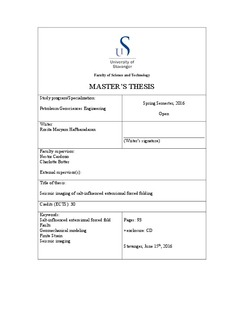| dc.contributor.author | Haftbaradaran, Rosita Maryam | |
| dc.date.accessioned | 2016-10-12T09:56:52Z | |
| dc.date.available | 2016-10-12T09:56:52Z | |
| dc.date.issued | 2016-06 | |
| dc.identifier.uri | http://hdl.handle.net/11250/2414499 | |
| dc.description | Master's thesis in Petroleum geosciences engineering | nb_NO |
| dc.description.abstract | Extensional forced folds are formed by the presence of a ductile salt layer, decoupling the overlying folded strata from the underlying faulted strata. Hydrocarbons are generally trapped within secondary structures of forced folds. The objective of this thesis is to analyze the impact of salt-influenced extensional forced folding and seismic parameters on the resultant seismic image. Fine-tuning the seismic parameters of illumination direction and wave frequency can help to better understand and potentially improve seismic imaging of salt-influenced extensional forced folding and secondary faults. To achieve this objective, a synthetic workflow is carried out in 2D, consisting of: i. mechanical modeling of salt-influenced extensional forced folding; ii. computation of finite strain in the mechanical model; iii. modification of the initial acoustic properties of the model based on finite strain; iv. seismic imaging using pre-stack depth migration (PSDM). This workflow is applied to three models; model 1 includes siliciclastic sediments, model 2 includes a salt layer below the siliciclastic sediments, and model 3 includes salt, siliciclastic sediments and growth strata. All the simulations produce realistic but different geometries and strain fields, with model 1 resembling a graben, localized above the major fault zone, model 2 displaying a forced fold with a wide distribution of associated secondary faulting, and model 3 displaying a steeper forced fold, and a wider distribution of secondary faulting. Seismic images of these models include different illumination directions (specular, left side and right side) and wave frequencies (10, 20, 30 and 40 Hz). Specular illumination highlights the flat reflectors outside the fault zone, also highlighting fault related diffractions. Offside illuminations target the dipping reflectors, where the left side illumination highlights the antithetic faults and right side illumination highlights the forelimb of the forced fold and synthetic faults. At a high frequency (30 Hz), the seismic images are more defined, creating better characterization of forced folding and secondary faulting. The evaluation of the combination of seismic parameters (i.e. illumination direction and wave frequency) is to generate a better seismic characterization salt-influenced extensional forced folds and faults. | nb_NO |
| dc.language.iso | eng | nb_NO |
| dc.publisher | University of Stavanger, Norway | nb_NO |
| dc.relation.ispartofseries | Masteroppgave/UIS-TN-IPT/2016; | |
| dc.subject | petroleumsteknologi | nb_NO |
| dc.subject | petroleum engineering | nb_NO |
| dc.subject | salt-influenced extensional forced fold | nb_NO |
| dc.subject | faults | nb_NO |
| dc.subject | geomechanical modeling | nb_NO |
| dc.subject | finite strain | nb_NO |
| dc.subject | seismic imaging | nb_NO |
| dc.subject | petroleum geosciences engineering | nb_NO |
| dc.subject | petroleumsgeologi | nb_NO |
| dc.title | Seismic imaging of salt-influenced extensional forced folding | nb_NO |
| dc.type | Master thesis | nb_NO |
| dc.subject.nsi | VDP::Technology: 500::Rock and petroleum disciplines: 510::Geological engineering: 513 | nb_NO |
